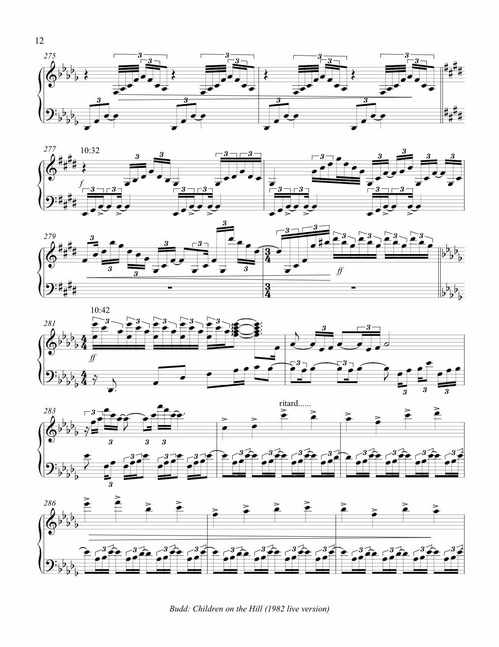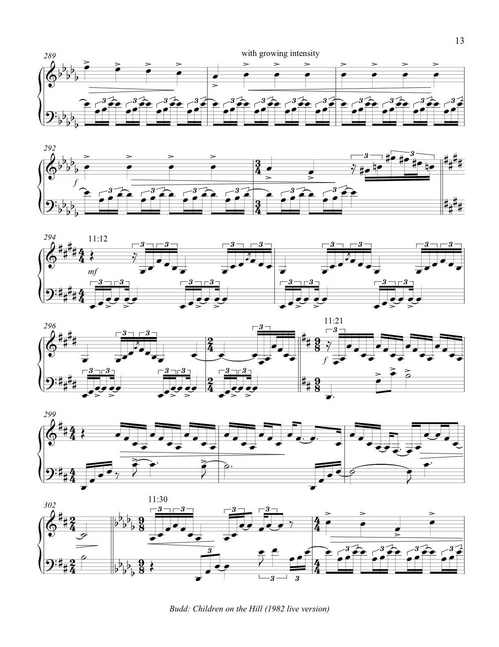OK. The night was Friday, July 9, 1982. I was administrative assistant for the New Music America festival in Chicago. I had a big argument with my then-girlfriend (whom I later married nevertheless) which turned out, surprisingly enough, to be all my fault. In a huff brought on by my inability to invent a benign rationale for my behavior convincing enough to satisfy even myself, I sulked out and vowed to walk from our apartment to the festival. As the distance was something under three miles, I had an hour to make it in, and it was a mild summer day, this was a less self-punishing exercise than it may sound. As I trudged up to Navy Pier, Harold Budd had just started playing the performance of his piece Children on the Hill that you can hear here. I stood in one of Navy Pier’s huge doorways simply transfixed. Rarely in my life have I heard another performance so lovely from beginning to end. Navy Pier is enormous, the crowd was huge and casual, and I have always been chagrined about the baby who wails like a banshee at many points during the recording.Â
For many years I have toyed with the idea of transcribing this wonderful recording, but given the speed of Budd’s cascading arpeggios in the 13-minute middle section, I doubted the feasibility until digital software rendered it possible to slow it waaaaay down (sometimes to 1/5th-speed) without changing the pitch, EQ-ing it to bring out selective registers. It’s taken dozens of hours of ear-stretching work over the last two years, but I’ve done it, and the amazing Sarah Cahill will finally recreate this performance at Kansas City on Friday, Sept. 4, at the Second International Conference on Minimalist Music. It’s the most difficult musicological feat I’ve ever attempted. The Well-Tuned Piano was child’s play by comparison.
You may (and should) be familiar with the five-minute version of Children on the Hill on Budd’s 1981 recording The Serpent (in Quicksilver) on the Cantil label, rereleased in 1992 on All Saints. That version never changes key or tempo, nor deviates from a B-major scale. This version is recognizably similar in motive and atmosphere, but enormously more complex. The main motive on the Cantil version is B-D#-E; here it is inverted, D#-E-G#. The opening section is based in B major, but abruptly shifts to D, C, and C#. The rapturous middle section, a torrent of Budd’s trademark major-seventh chords, alternates at first between E and Db, but moves upward though D and Eb to an alternation of F and Gb before finally settling back to C# for the ending recapitulation. At no time does the key jump more than a minor third away. Interestingly, each key is associated with a particular textural configuration, so that every return of a key is also the return of a type of arpeggio and melody. Often transitions between keys are introduced by the right hand entering the new key first, so that the left hand resolves a poignant moment of bitonal dissonance. Budd says that he would sometimes use written-down motives on a scrap of paper as a guide, but that these notations are long gone. And, looking at my transcription, he wrote, “I couldn’t play that in a thousand years.”
Below I post my transcription of the segment from 10:30 to 11:32 on the recording. My rhythms are pretty conjectural, often simply an attempt to get all the notes in the right order. The fact that the piano is run through a harmonizer added to the difficulty. Sarah’s working hard, though, and practicing along with the recording to get the unnotatable nuances of rhythm and pacing. I am thrilled that I’m finally going to get to hear this music live again, and get a recording without the crying baby. That kid must be 27 now, and in Kansas City bouncers will be on the lookout for a suspicious 27-year-old.
Comments closed. I thought this Budd was for you, but I guess it was for someone else.


